
On Wednesday, February 11, the New Art Center in Newton, Massachusetts, provided a guided tour of its latest exhibit Sensory Garden. Chenoa Baker, curator of the exhibit, said the featured works cultivate a wintertime oasis amidst political, social, and cultural transition. She added that she and the 24 artists honor and prompt viewers’ experiences as a lodestar for self-awareness and emotional healing.
The guided tour began with introductions from New Art Center Executive Director Emily O’Neil and Development Director Jan Taylor. They welcomed patrons into the space with warm enthusiasm before turning the event over to Baker to speak on the origins of the exhibit. Baker described the roots of Sensory Garden. During the COVID-19 pandemic, she lived with her parents and her father grew passionate about gardening. Through his love for the craft, she began to appreciate the sensory-laden experience. The garden proved a sanctuary in a fraught time and this notion of beauty despite hardship reminded her of the victory gardens during World War II. Where there is pain and devastation, there is a need for artistic creation. Thus emerged the genesis of Sensory Garden.
Baker noted that when she put out the artist call, she stayed open to medium and genre. She craved art that fostered a connection with nature and ourselves, art that grounded and preserved us through all our senses. Three featured artists exuded a quiet excitement as they stood near Baker.
The curator walked along the corridor and stopped at “There are Twice as Many Stars as Usual”, a piece by Rowan Raskin made of acrylic and oil paint on canvas with hemp rope. This work speaks to the trans experience right now, Baker said, her fingers hovering in front of a golden skeleton. This skeleton symbolizes death without the gore and bloodiness.
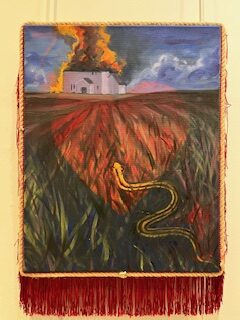
Baker stepped to the left and pointed to “7 of Hearts”, another piece by Rowan Raskin made of charcoal, acrylic, and oil paint on canvas with hemp rope, fringe, and bobcat talon sheaths. The snake in the foreground slithering towards the burning house is the destruction of trans rights, Baker said. Also note the border, she said, Raskin plays around with creative materials and is masterful at cultivating the whole artwork, not simply the canvas.
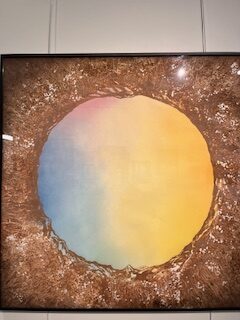
Baker walked back to her original position and pointed to “Planet I”, a mixed media piece by Ponnapa Prakkamakul made on paper with soil, minerals, and found chañar tree charcoal from San Pedro de Atacama River in Chile. Baker spoke of the artist’s panoramic view of San Pedro, how Prakkamakul collected minerals and materials from the environment and incorporated them into the paper.
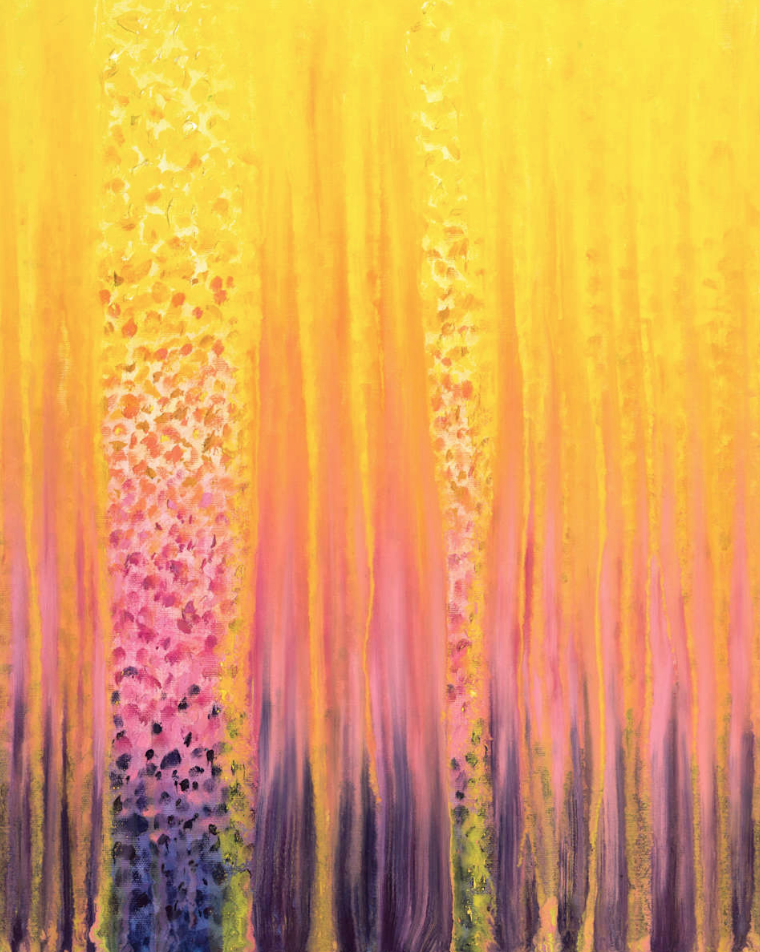
The curator introduced featured artist Rachel Brask who stood by her three oil paintings on canvas titled “A Host of Golden Daffodils in the Rain,” “That Sunset Gradient Rain Revealed,” and “Ocean Rain Storm Rolling In.” Brask described her style – pointillism into undoing. She explained the delicate nature of crafting dots along the canvas before using stand oil to smear away the dots, creating a vibrant mirage. Brask completed these steps over and over. It’s similar to a rainy day, Brask said, the idea of something washing away, the need to rebuild. Brask became interested in her signature style years ago, but the COVID-19 pandemic allowed her to hone her skills. Thus emerged the rain series. She urged viewers to touch the paintings, experience the tactile joy of those dots. My work may only live on for the next 50 years, Brask said, and I want people to touch, feel, experience all of my art.
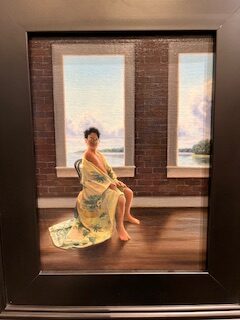
Exhibit artist Lucy Yan stepped forward to detail her pieces “Sunshine” and “Missing.” She moved in front of “Sunshine” and pointed to the person draped in a kimono. This is my wife just after she had top surgery, Yan said, I wanted to juxtapose the stuffy academic environment with color and modern portraiture. Yan added that her wife grew bored of sitting after a while and the artist completed the oil on linen without her wife present. I hope through this work that people see just how obsessed I am with my wife, she said.
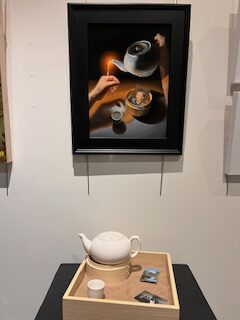
Yan walked across the corridor and stopped at “Missing.” My grandfather passed away a few years ago, Yan started, and tea was something we often shared. She explained that to capture the image of pouring herself tea, she brought a tripod into a dark room and took one photo after another occupying different angles of the space. I felt silly, she admitted, but it helped me understand perspective.
Featured artist Raquel Fornasaro stood next to her installation “Heal.” She glanced from the metal stand to the IV bag with an avocado sprout to the accompanying video on a television screen. Growing up in Brazil, I witnessed ecological devastation, she said, and this piece reflects the environmental damage of the past 50 years. I wanted to combine this pain with the power of roots taking hold in our lives, of possible restoration. Fornasaro explained that much of her work centers around ecology and environmentalism. I’m not a political activist, she said, but my artwork is my way of showcasing the urgent need to restore our environment.
Sensory Garden runs through February 28 at the New Art Center. For more information, visit https://newartcenter.org/sensory-garden/.